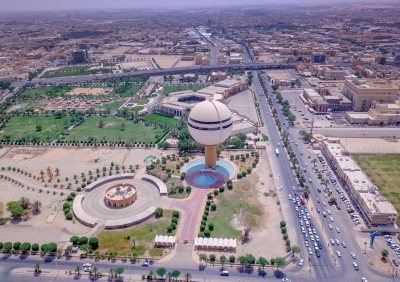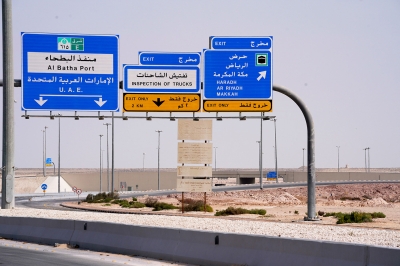
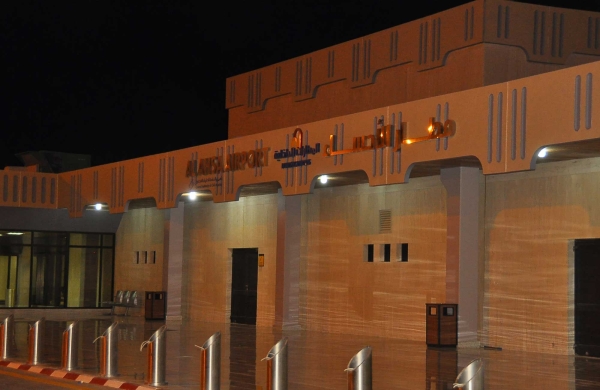
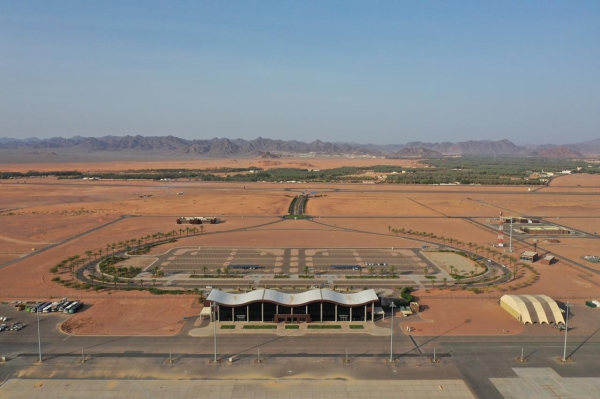
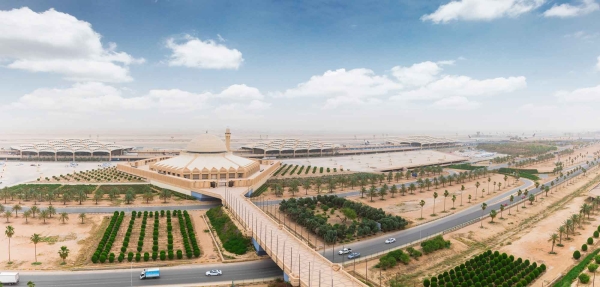
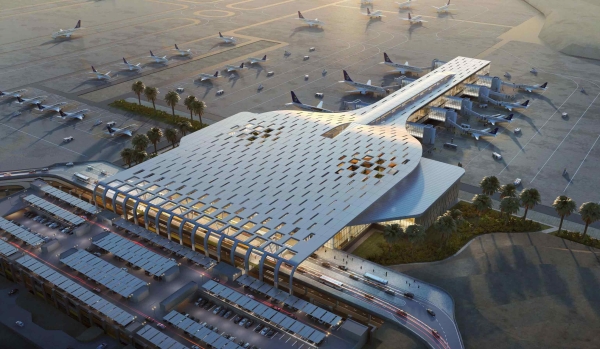
The International Airports in the Kingdom of Saudi Arabia connect the Kingdom to the outside world. The growing travel movement to and from the Kingdom has led to the establishment of international airports that annually transport millions of passengers, witnessing heavy traffic, especially from pilgrims, Umrah performers, and visitors.
International airports are distributed throughout most provinces of the Kingdom, with some areas hosting more than one international airport. Some airports were initially established as domestic airports and later were upgraded to regional and then international status. These airports are under the supervision of the General Authority of Civil Aviation (GACA).
International airports in Saudi Arabia
The list of international airports in the Kingdom includes: King Khalid International Airport in Riyadh, King Abdulaziz International Airport in Jeddah, King Fahd International Airport in Dammam, Prince Mohammed Bin Abdulaziz International Airport in al-Madinah al-Munawwarah, Taif International Airport, Prince Abdulmajeed Bin Abdulaziz International Airport in al-Ula, Abha International Airport, Prince Naif Bin Abdulaziz International Airport in Qassim, Prince Sultan Bin Abdulaziz Airport in Tabuk, al-Jawf International Airport, al-Ahsa International Airport, NEOM International Airport, Hail International Airport, al-Qaisumah International Airport, King Abdullah Bin Abdulaziz Airport in Jazan, Prince Abdulmohsin Bin Abdulaziz Airport in Yanbu, Najran Airport, and Red Sea International Airport.
In 2022, the general plan for King Salman International Airport in Riyadh was announced, aiming to make Riyadh a gateway to the world and a global destination for transportation, trade, and tourism.
King Khalid International Airport in Riyadh
Located in Riyadh, the capital of the Kingdom, it was opened in 1983, covering an area of 225 km², approximately thirty-five km from the city center. The airport comprises five main passenger terminals, and forty boarding bridges, in addition to two terminals for private aviation and a royal terminal. The airport also houses a central control tower, and two parallel runways, which are each 4,260 m (13,980 ft) long, with a car parking designed for 11,600 vehicles. King Khalid International Airport is served by fifty-eight international and domestic airlines, operating 217,000 flights annually to 105 destinations. The airport accommodates more than 28.5 million passengers each year and is managed by Riyadh Airports Company. Its annual cargo capacity reaches six hundred thousand t at its cargo village.
Growth rate
King Khalid International Airport witnessed a 14 percent growth in passenger numbers in the third quarter of 2023, reaching 8.6 million passengers compared to 7.6 million passengers in 2019. Additionally, the number of flights increased by 9 percent, totaling around 55,000 flights compared to fifty thousand flights in the third quarter of 2019.
The number of passengers heading to domestic destinations increased by 2 percent compared to 2019, while the percentage of passengers to international destinations rose by 24 percent, reaching 3.4 million passengers. The average daily number of passengers through King Khalid International Airport exceeded 94,000 during the third quarter of 2023, compared to 83,000 passengers in the third quarter of 2019. The average number of daily flights during the third quarter of 2023 reached 597 flights, with a 9 percent increase compared to the average number of flights, which was 550 for the same period in 2019.
The total workforce at King Khalid International Airport, across all airport facilities and sectors, amounted to about 25,000. The number of operating airlines at the airport during the third quarter of 2023 was fifty-seven, compared to forty airlines in the second quarter of 2019. The total number of destinations to and from the airport during the third quarter of 2023 reached 108, including twenty-five domestic destinations and eighty-three international destinations, compared to eighty-nine destinations for the same period in 2019. The total cargo handled witnessed a 53 percent increase, reaching 85,000 t, compared to 44,000 t for the same period in 2019.
Development of international terminals
In 2019, development projects were completed in International Terminals One and Two at King Khalid International Airport. The projects included the development of baggage claim areas, main gates, and passenger waiting areas in departure and arrival lounges, aiming to enhance efficiency and quality, increase capacity, and expand the services provided.
The projects also included the construction of two additional departure gates on the departure floor of International Terminal Two, bringing the total to ten gates and increasing seating capacity by 486 seats to a total of 1,616 seats. Additionally, the baggage handling capacity was increased by 300 percent in Terminals One and Two arrival halls, from 1,600 bags per hour to 4,800 bags per hour. Furthermore, the passenger and baggage inspection area in Terminals One and Two was expanded from nine to twelve lanes to expedite inspection procedures and streamline entry into the departure gate area.
King Khalid International Airport inaugurated a new private aviation lounge in 2019, covering an area of 2,617 m². Additionally, the aircraft parking apron area was doubled to accommodate more aircraft, and the number of parking spaces was increased in the new aviation lounge, aiming to enhance the capacity and operational efficiency of the private aviation area.
In 2018, a project to develop the passenger and baggage inspection area in the departure area of Terminals One and Two at the airport was completed. The project included organizing passenger entry lanes and increasing passenger capacity by adding more inspection devices.
Managment of digital platform
In 2022, the General Authority of Civil Aviation (GACA) inaugurated the digital platform 'Ofoq' for King Khalid International Airport, which includes a central database for operational information sourced from the airport. The platform incorporates an airport resource management system that enables operational teams to automatically control and schedule airport assets, including aircraft stands, passenger check-in desks, boarding gates, and baggage conveyors. The platform also includes a Flight Information Display System (FIDS), which provides accurate data and displays flight information precisely and synchronously with real-time changes in flight status.
Airport services
King Khalid International Airport launched several services and projects in 2018, including 'Ask Me,' a service provided by young men and women who roam inside the airport lounges to assist travelers in over ten languages. Additionally, a unified call center was established to answer travelers' inquiries and receive their feedback around the clock.
In the same year, the websites of King Khalid International Airport and Riyadh Airports were launched, providing services and information needed by arriving and departing travelers, investors, and the business sector. Additionally, the 'Riyadh Airports' app was launched, allowing travelers to access their travel information, estimate the time it will take from their home to the boarding gate, view the airport map and facilities, and access all services and amenities provided, with the added benefit of complimentary internet access.
The airport also allocated 'long-term parking' spaces at reduced rates for those wishing to park their cars for extended periods, with the option for self-payment for international terminal parking spaces. Additionally, a valet parking service was launched for departing travelers at both international and domestic terminals.
The airport launched the Curbside Check-In service to facilitate flight check-ins, issuance of boarding passes, and luggage drop-off for International Terminals One and Two.
The airport launched the 'Mazaya' program, which includes several services, such as luggage transfer from home to the airport or vice versa, luggage shipping, and preparing the boarding pass for the traveler upon arrival. Additionally, participants in the program benefit from the 'Fast Track' service, which allows travelers to complete arrival or departure procedures within minutes through a dedicated lane, enabling them to complete travel procedures without the need for waiting.
The 'Towsalak' service was introduced to transport domestic workers from the airport to their employers' homes. This service exempts clients who have a domestic worker arriving at the airport from the hassle of coming to the airport and completing the procedures.
In 2022, the airport launched an updated version of its interactive chat service via the 'WhatsApp' and 'X' applications, enhanced with artificial intelligence technology. This service replaces lengthy texts and menus with a set of options, allowing users to simply tap on the menu and choose the service to obtain results quickly and easily. It also provides flight notifications in sign language for the deaf and mute, in addition to offering information about airport services. This enables travelers and airport visitors to inquire about flights, service prices, and other necessary information with ease.
The airport launched an initiative in 2021, equipping a sensory room for children with disabilities in Domestic Terminal Five. The room controls available tools and devices to stimulate various senses of individuals: sight, hearing, touch, taste, and smell, providing enjoyment and relaxation for users.
The Airport Operations Control Center
King Khalid International Airport inaugurated the Airport Operations Control Center (AOCC), overseeing approximately seven hundred flights daily for passengers, air cargo, and private aviation. The center brings together over twenty-five operational, security, and service entities from airport stakeholders in one place to ensure enhanced integration among all airport sectors, immediate information sharing, and faster, more effective decision-making. This facilitates smoother operational flow, housing modern operational systems related to resource management, operation monitoring, and performance indicators for airport management around the clock. The center enables Riyadh Airports Company to control its operational processes across its various facilities, allowing proactive measures based on data, thus improving planning operations.
The model Cargo Village
The total area of the Cargo Village at the airport is 275,000 m², inaugurated in 2020, serving as a logistical platform. According to statistics from the third quarter of 2020, the total number of air cargo flights reached approximately 2,673 flights, surpassing fifty destinations worldwide from the Cargo Village.
Energy Efficiency project
The airport launched an energy efficiency project in 2021, aimed at increasing energy efficiency in terms of consumption and cost, ensuring the reliability of its supply by using clean and renewable energy sources, and transforming airport facilities into smart and environmentally friendly buildings.
King Salman International Airport in Riyadh
On November 28, 2022, His Royal Highness Prince Mohammed Bin Salman Bin Abdulaziz Al Saud, crown prince, prime minister, chairman of the Council of Economic and Development Affairs, and chairman of the Board of Directors of the Public Investment Fund, announced the launch of the master plan for King Salman International Airport, aiming to make Riyadh a gateway to the world, a global hub for transportation, trade, and tourism, and a bridge connecting the East and the West, solidifying the Kingdom's position as a global logistics center.
Area
The new airport contributes to supporting the Kingdom's plans for Riyadh City to be among the top ten city economies globally and to keep pace with the continuous growth in the population of the capital, Riyadh, which aims to reach between fifteen and twenty million people by 2030. King Salman Airport will be one of the largest airports in the world, covering an area of approximately fifty-seven km². It includes the current terminals known as King Khalid Terminals, six runways, in addition to twelve km² of supporting facilities, residential assets, recreational areas, commercial outlets, and numerous logistic facilities.
King Salman International Airport prioritizes sustainability, aiming to achieve LEED Platinum certification for environmentally friendly projects. It will be supported by renewable energy resources.
Capacity
King Salman International Airport is working to increase its capacity to accommodate up to 120 million passengers by 2030, with a target of reaching 185 million passengers. Additionally, it aims to handle 3.5 million t of cargo by 2050.
The project is expected to contribute approximately SAR27 billion annually to the non-oil gross domestic product (GDP) and create 103,000 direct and indirect job opportunities to contribute to achieving the targets of Saudi Vision 2030.
King Abdulaziz International Airport in Jeddah
It serves as the aerial gateway to Makkah al-Mukarramah, symbolized as 'JED' by the International Air Transport Association (IATA) and 'OEJN' by the International Civil Aviation Organization (ICAO). Through it, pilgrims and Umrah performers reach the Grand Mosque in Makkah al-Mukarramah. It also houses the world's fourth-largest passenger terminal, the Hajj Terminal, covering an area of 510,000 m². In 2022, the airport was ranked among the top fifty airports globally according to the Skytrax World Airport Awards, which assess airlines and airports worldwide.
The new King Abdulaziz International Airport project won the award for the best engineering project at the Eighth International Infrastructure Forum in 2015, held in New York City, USA. This recognition was attributed to its distinguished architectural designs characterized by their Islamic identity, suitable for the Saudi environment.
It was established in 1981. It comprises three terminals, with the airport's total area estimated at around 105 km², and the total built-up area covering ninety-one km². The airport's passenger capacity at the beginning of its establishment reached 7.5 million passengers, but it increased after its expansion in 2019 to thirty million passengers annually.
Airport facilities include: banks, tourism and travel services, restaurants and cafes, car rental services, telecommunications companies, retail shops, taxis, hotels, and ATMs.
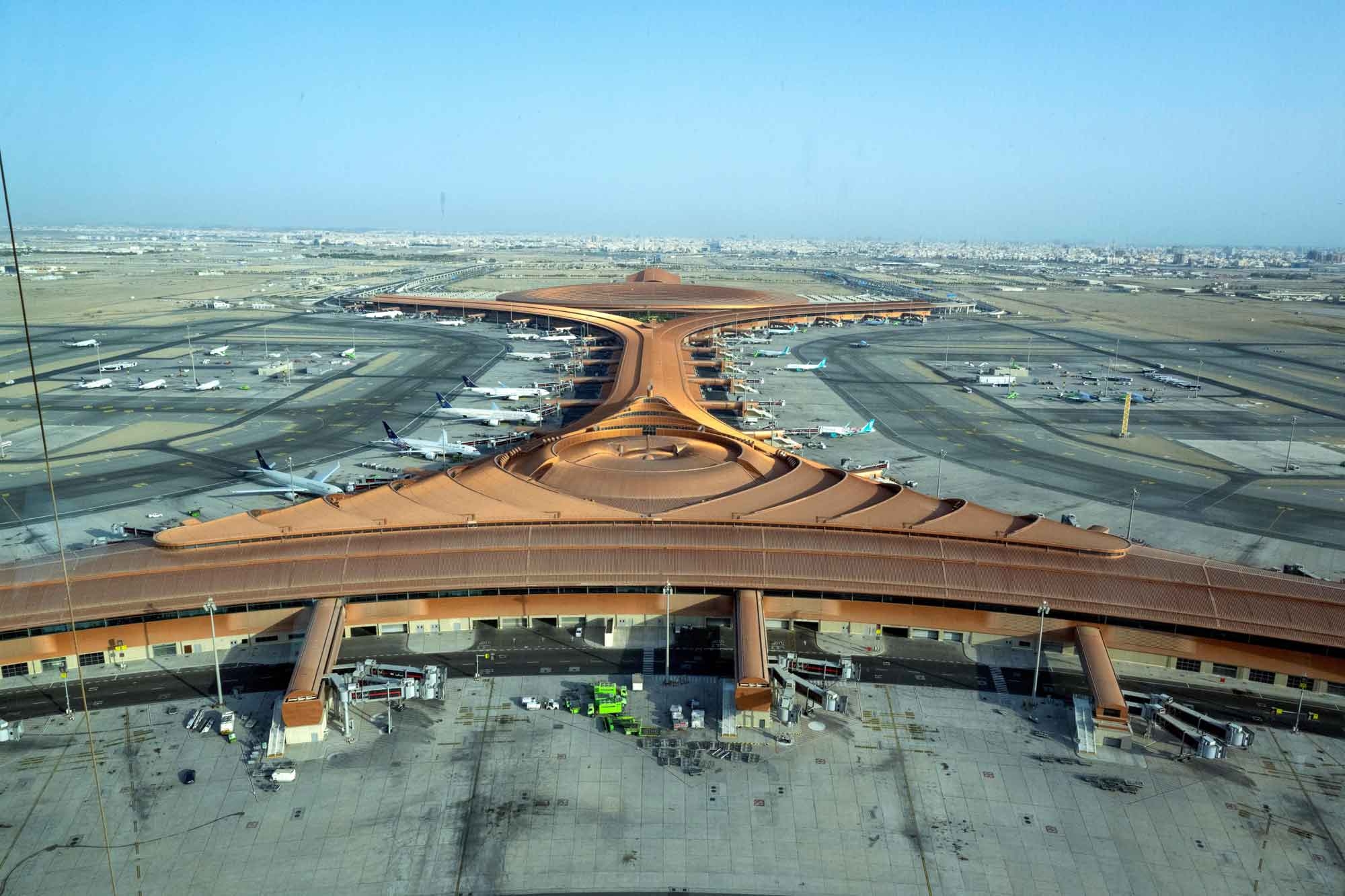
Airport terminals
King Abdulaziz International Airport in Jeddah comprises three terminals: the Hajj and Umrah Terminal, Terminal One, and the North Terminal. The total area of these terminals exceeds 1.3 million m², accommodating over 127,000 passengers daily.
The Hajj and Umrah Terminal complex features twenty modern halls, covering an area of 1,200 m² each, equipped with a water-cooled air conditioning system with a capacity of 2,500 t. These halls accommodate six thousand seats and offer various services including: essential facilities, rest areas, designated spaces for restaurants and commercial services, secure packaging centers, as well as a station for the Haramain High-Speed Railway, bus stops, and taxi stands. The total area of the Hajj and Umrah Terminal complex is 510,000 m², hosting ten moving bridges and fourteen departure lounges capable of accommodating 42,000 departing passengers and 45,000 arriving passengers per hour. Additionally, it includes 222 passport control gates and 166 checkpoints for departure procedures.
The first terminal at the airport covers an area of 810,000 m², housing eighty self-service kiosks, 220 counters, forty-six gates, and ninety-four bridges to serve passengers, including pilgrims to the Grand Mosque.
The northern terminal at the airport spans an area of 55,000 m², accommodating fifty-four gates for departure procedures. Additionally, it includes six self-service platforms and fifty-five passport control stations, and provides parking for 1,919 vehicles.
The new airport also features a commercial area for domestic departure lounges covering 7,856 m². The commercial area for international departure lounges spans 12,218 m². Additionally, it houses a three-story hotel with 120 rooms. Furthermore, lounge number one boasts the world's largest water feature, with a height of 14.2 m and a diameter of ten m.
Facilities
The facilities of King Abdulaziz International Airport in Jeddah serve three main power centers, providing around 475 MW of electricity, with a capacity of 110,000 t of chilled water and forty-six fire-fighting water pumps. Additionally, the new airport also features two integrated information centers to serve the airport and manage all smart systems within it.
The airport facilities include a public transportation center located between the terminal complex and the multi-story parking building, allowing passengers and airport visitors easy access. It connects the terminal building, multi-story parking building, train and metro station, taxi stand, and bus station, providing airport visitors and travelers with various ground transportation options. The center also features several restaurants and cafes.
A complex for rescue and firefighting was established as a part of the King Abdulaziz International Airport development project according to international standards, ensuring the safety and security of passengers, aircraft, and airport facilities. This upgrade elevates the airport's international classification to category ten, the highest international rating related to readiness and preparedness for emergencies.
The airport administration began operating the free internal automated shuttle service, known as the 'Internal Train,' in 2020, to transport departing and arriving international flight passengers within the new airport building in Terminal One, from the departure procedures area to the international departure terminals and vice versa.
Growth rate
Passenger traffic at the airport witnessed leaps in the years prior to the 'COVID-19' pandemic, with passenger numbers exceeding thirty-four million by the end of 2017, marking its highest growth in history at 9.4 percent compared to thirty-one million passengers in 2016. Flight movements also witnessed growth by the end of 2017, reaching 3.46 percent compared to 2016, with a total of 226,794 flights in 2017 compared to 219,202 flights in 2016.
The number of passengers through the northern terminal also increased in 2017 by 13.9 percent compared to 2016, while the number of passengers through the southern terminal increased in 2017 by 8.5 percent compared to 2016. Additionally, the increase in the number of passengers through the Hajj and Umrah terminal in 2017 was approximately 5.7 percent compared to 2016.
Expansion
The recent expansion of the airport (Terminal One) was inaugurated on September 24, 2019. Following this expansion, the airport now accommodates 70 percent of the total number of pilgrims and Umrah performers. The terminal complex at the airport serves all airlines, featuring 220 airline counters, eighty service desks, 128 passport control counters, and forty-six gates, some of which accommodate large aircraft. These gates are connected to ninety-four moving bridges serving seventy aircraft simultaneously, alongside parking spaces for more than 21,000 vehicles.
The General Authority of Civil Aviation (GACA) launched the new project to develop King Abdulaziz International Airport in 2007, located nineteen km north of Jeddah, with an initial capacity of more than thirty million passengers by the end of the first phase. This capacity will increase to over sixty million passengers in the second phase and exceed one hundred million passengers by the end of the third and final phase. Completion of all three phases of the project is expected by 2035.
Pilgrims' services
The airport annually develops an operational plan for the Hajj season, involving security, governmental, and operational entities. This is facilitated through a joint operations room for monitoring and tracking operational activities in the airport's three terminals: the Hajj and Umrah Terminal, Terminal One, and the North Terminal. The total area of these terminals exceeds 1.3 million m², accommodating over 127,000 passengers daily. The complex of Hajj and Umrah terminals comprises twenty halls. The terminals include essential services and amenities, designated areas for restaurants and commercial services, packaging centers, as well as a station for the Haramain High-Speed Railway, and areas for buses and taxis.
Jeddah Airports Company, the operator of King Abdulaziz International Airport, along with governmental, security, and operational entities operating at the airport, work to provide the necessary human resources to serve the pilgrims. The Hajj and Umrah terminals at the airport receive incoming flights from Dhul Qadah 1, until Dhul-Hijjah 6. Then, they are reconfigured again for departing flights only from Dhul-Hijjah 14, until Muharram 15.
The airport launched a campaign to facilitate baggage handling during the return journey of pilgrims, ensuring compliance with the allowed weight according to the travel ticket, and avoiding placing liquids inside the luggage or tying the bags with ropes that may cause their shipment to be disrupted. The airport focuses through its operational plan on transporting and shipping luggage during the departure phase of passengers, ensuring smooth workflow and organization within the airport terminals, thereby expediting the procedures for pilgrims' grouping for the departure phase.
King Fahd International Airport in Dammam
King Fahd International Airport in Dammam (IATA: DMM, ICAO: OEDF), the primary air gateway to the Eastern Province, is witnessing active commercial and industrial traffic.
The airport is the third largest international airport in the Kingdom in terms of passenger traffic, after King Khalid International Airport in Riyadh and King Abdulaziz International Airport in Jeddah. It was inaugurated in 1999, and the area of the airport lands is 776 km². It houses one terminal, combining modernity with Islamic architectural character in its design. Dammam Airports Company has been operating and managing the airport since 2017.
The airport hosts thirty-seven airlines operating flights to forty-three domestic and international destinations, with an annual capacity of accommodating up to ten million passengers. In 2022, the airport operated approximately 13,120 flights to thirty-six international destinations, in addition to 15,697 flights to fourteen domestic destinations.
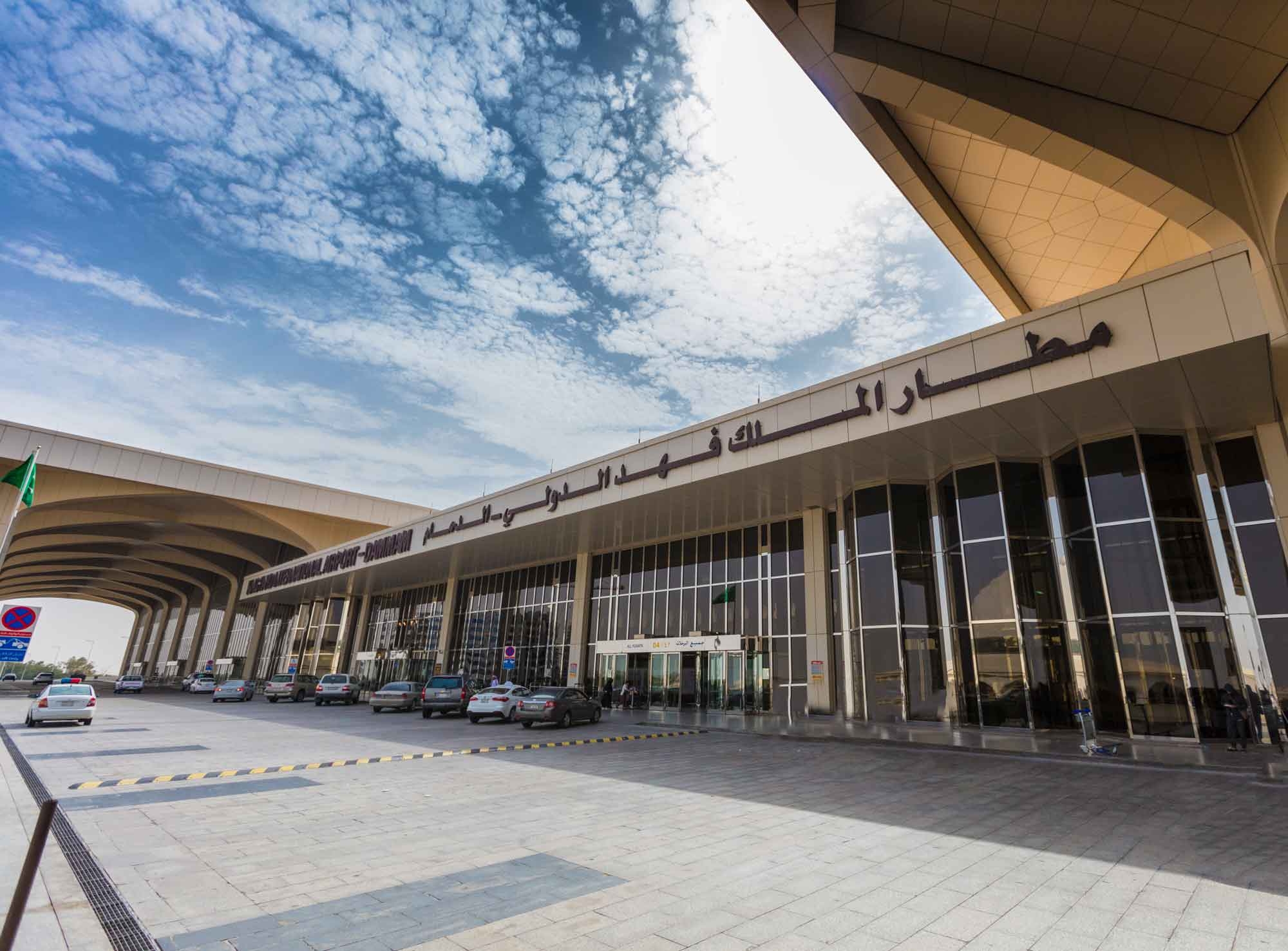
Location
King Fahd International Airport in the city of Dammam is connected to residential areas via two main roads. The northern exit of the airport leads to al-Qatif Governorate through a four-lane expressway, while the southern exit of the airport in Dammam City is connected by a six-lane expressway on King Fahd Road, which is the main road to the airport.
The airport is located close to residential areas in the Eastern Province, especially the cities of Dammam and al-Jubayl. Below are the estimated distances and times to reach the airport from some cities in the Eastern Province and in the Kingdom of Bahrain:
Dammam: 35.6 km (22 mi.), twenty-five minutes.
Al-Qatif: 36.5 km (23 mi.), thirty minutes.
Dhahran: 46.8 km (29 mi.), thirty-five minutes.
Al-Khubar: 57.9 km (36 mi.), forty minutes.
Al-Jubayl: 93.4 km (58 mi.), sixty minutes.
Manama - Bahrain: 103 km (64 mi.), ninety minutes.
Dammam Airports Company
A decision was issued on the privatization of the King Fahd International Airport management, transferring it to Dammam Airports Company (DACO), in 2017. The company, headquartered in Dammam, is responsible for operating King Fahd International Airport, while al-Ahsa International Airport and al-Qaisumah International Airport were merged into it in 2021.
The company works on developing infrastructure, operating and enhancing airport facilities, and managing commercial and investment relations. Additionally, it operates air cargo facilities, enhances the operational capabilities and efficiency of airports, and keeps pace with the evolution of the aviation industry.
Among the projects completed by Dammam Airports Company (DACO) are: Cargo Villages 'A' and 'B', the development and replacement of passenger boarding bridges, the expansion of the passport control area, as well as the construction of six new aircraft parking stands. Additionally, there's the establishment of a passenger waiting lounge for domestic flights, upgrading of signage in the airside area, and the creation of an internal arrival gate for remote stands.
Cargo Village
The cargo village at the airport was inaugurated in 2015, to become a key economic driver in the shipping and logistics sector in the Kingdom. It provides shipping and cargo services, capturing a significant share of the regional cargo market. The village offers various solutions for shipping, storage, and customs clearance, all in one place. The total area of the cargo village at the airport is six million m², with a current capacity of 650,000 t. By 2030, its capacity is expected to reach two million t annually.
Training academies
The airport hosts an international aviation maintenance training academy, where the Saudi National Aviation Academy at the airport signed an agreement with the German 'Lufthansa Technik' Academy in 2019 to establish the academy. The academy is expected to graduate two thousand aviation technicians annually, specializing in various fields, including technicians working on large civilian and military aircraft. They undergo training by the German Lufthansa in collaboration with the Saudi National Aviation Academy at King Fahd International Airport in Dammam. The academy will provide training and graduate technicians ready for the job market, qualified and licensed by Germany and with European licenses. Later, they will also be qualified with parallel Saudi licenses equivalent to those issued by the aviation authority.
King Fahd International Airport in Dammam also hosts the Saudi National Aviation Academy, whose first phase was inaugurated in 2018, represented by the Oxford Aviation Academy in Dammam.
Prince Mohammed Bin Abdulaziz International Airport in al-Madinah al-Munawwarah
It represents the aerial gateway to the Prophet's Mosque, and it is one of the most important points of arrival and departure for pilgrims and Umrah performers from outside the Kingdom.
The airport was officially inaugurated at its new headquarters on July 2, 2015, although air traffic at the airport commenced almost two years earlier. In the first phase, the airport accommodates more than eight million passengers annually, while its capacity will reach fourteen million and twenty-seven million passengers annually in the second and third phases, respectively.
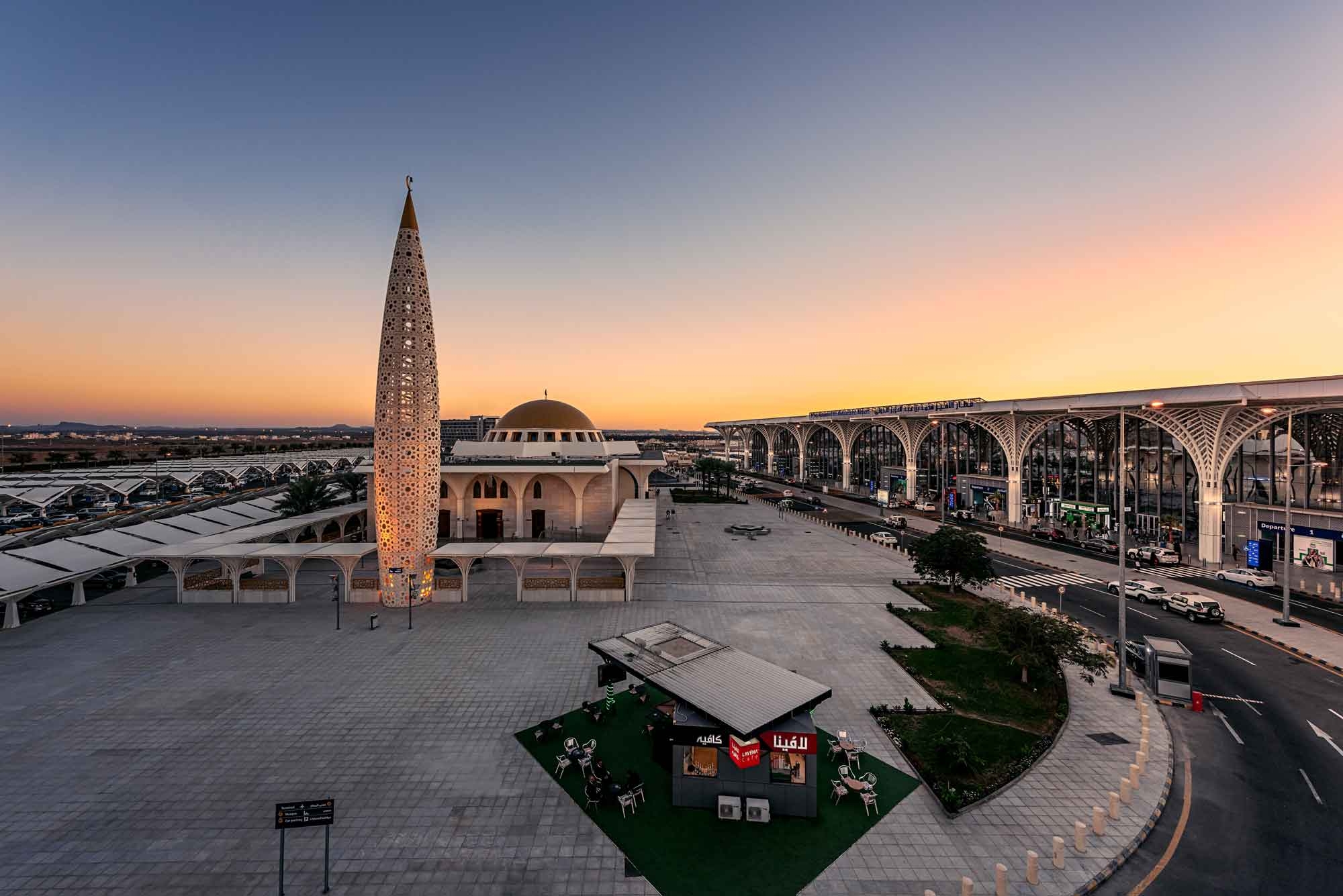
Establishment
The airport was established in 1950, initially as a domestic airport that only received international flights during the Hajj season from Cairo, Damascus, and Istanbul. However, it was converted into an international airport in 2006, following a significant increase in the number of flights during the Hajj and Umrah seasons. It became a part of the Kingdom's international airport system. Since its establishment, the airport has witnessed several expansions and continuous development programs. It welcomes pilgrims and visitors to the Prophet's Mosque throughout the year.
Capacities
The airport is located northeast of al-Madinah al-Munawwarah, fifteen km from the city center, occupying an area of four million m². It comprises two runways and a terminal building covering an area of 156,000 m². It has thirty-two departure gates directly connected to aircraft via passenger boarding bridges and nine gates for passenger transportation by buses between the terminals and aircraft. The number of parking spaces is one thousand for cars and 250 for buses. Additionally, the airport includes a royal lounge, a VIP lounge, and executive offices.
There is also a transit passenger service at the airport. It is designed for passengers transiting from one international station to another through the airport. There is a dedicated platform for completing travel procedures in the international arrival hall before passport control checkpoints.
Tibah Airports Operation Company
Tibah Airports Operation Company manages and operates Prince Mohammed Bin Abdulaziz International Airport in al-Madinah al-Munawwarah. It is the first private sector company to manage and operate an airport in the Kingdom, and it began operating the airport in 2012.
It is the first airport in the Kingdom to be built and fully operated by the private sector, following the Build-Transfer-Operate (BTO) model, in collaboration with Taibah Airport Development Company. This is a consortium composed of ‘TAV Airports Holding’, al-Rajhi Holding Group, and ’Saudi Oger Limited’.
Pilgrims' services
Prince Mohammed Bin Abdulaziz International Airport in al-Madinah al-Munawwarah serves as one of the entry points for Hajj pilgrims, as well as visitors to the Prophet's Mosque. Therefore, the airport develops an annual plan to receive pilgrims arriving on thousands of flights. The airport can accommodate eighteen aircraft of various sizes at gates connected to bridges, in addition to eight aircraft accessed by buses. The international arrival hall and the two Hajj halls can handle sixteen flights simultaneously. Bus parking spaces opposite the main passenger terminal can accommodate up to fifty buses, along with current bus parking areas in the pilgrim rest area, which can hold up to one hundred buses. The lower Hajj hall can accommodate four flights at once. The airport prepares the Hajj halls in collaboration with government and private entities operating at the airport, in preparation for receiving pilgrims through the second air gateway of the Two Holy Mosques during the arrival phase, starting from Dhul Qadah 1, until Dhul-Hijjah 4, while the departure phase starts from Dhul-Hijjah 13 to Muharram 13.
The reception and departure lounges, as well as the plaza area (the pilgrim rest area), are equipped with 102 passport processing platforms for arrivals, eighty-six counters for departures, and 108 service counters for travel procedures. Additionally, the lounges and areas designated for pilgrims contain essential services they may require. The operational plan for the Hajj season includes completing pilgrims' procedures within a timeframe not exceeding sixty minutes for each flight departure.
The 'Makkah Route' initiative, implemented by the Ministry of Interior at Prince Mohammed Bin Abdulaziz International Airport in al-Madinah al-Munawwarah, has contributed to reducing the processing time for pilgrims. The initiative involves completing pilgrims' procedures in their own countries, starting from electronically issuing visas and obtaining biometric data, followed by passport procedures at the departure airport after verifying health requirements. Additionally, it includes luggage coding and sorting according to transportation and accommodation arrangements in the Kingdom. Upon arrival, pilgrims are directly transferred to buses to their accommodations in Makkah al-Mukarramah and al-Madinah al-Munawwarah via dedicated routes, while the relevant entities ensure the delivery of their luggage to their residences.
Statistics
The airport statistics from 2007 to 2019 show a steady growth in the number of passengers annually:
2007: 3.05 million passengers.
2008: 3.41 million passengers.
2009: 3.81 million passengers.
2010: 3.25 million passengers.
2011: 3.55 million passengers.
2012: 4.59 million passengers.
2013: 4.00 million passengers.
2014: 4.16 million passengers.
2015: 5.83 million passengers.
2016: 6.57 million passengers.
2017: 7.8 million passengers.
2018: 8.1 million passengers.
2019: 8.4 million passengers.
Development
The General Authority of Civil Aviation (GACA) has conducted studies to develop the airport, covering its needs over a quarter of a century. The project includes the construction of new passenger terminals with movable bridges, followed by other facilities to accommodate the increasing numbers of passengers arriving and departing on international and domestic flights over the next twenty-five years. This also involves expanding the Hajj and Umrah terminals and increasing the capacity from four hundred thousand passengers per month to one million passengers per month. This helps in implementing a single-track system for transporting pilgrims and Umrah performers arriving between Makkah al-Mukarramah and al-Madinah al-Munawwarah. Additionally, the plan aims to facilitate the movement of pilgrims arriving and departing from al-Madinah al-Munawwarah, ensuring their safety and comfort, and providing them with the best services possible.
The plan for implementing the second phase of the project includes increasing the airport's capacity to accommodate fourteen million passengers, once the capacity of the first phase is exhausted. Meanwhile, the third phase will raise the international airport's capacity to accommodate up to twenty-seven million passengers.
Taif International Airport
Taif International Airport (IATA: TIF, ICAO: OETF) is one of the international airports in the Kingdom, and one of the air access points for pilgrims and Umrah performers, due to its proximity to the distance between Taif and Makkah al-Mukarramah, as well as serving the active tourism movement in the city of Taif.
The airport is located in Taif Governorate in Makkah al-Mukarramah Province, established in 1976, five years before the establishment of King Abdulaziz International Airport in Jeddah, and it is located about twenty-seven km away from the center of Taif city in the northeast direction.
Capacity
The airport has a capacity of 550,000 passengers and houses one terminal, with a total built-up area of 0.0056 km².
The airport serves both domestic and international flights in the Kingdom, serving as the aerial gateway to Taif as a summer destination in the Kingdom. It also facilitates the movement towards the Holy Sites during the Hajj and Umrah seasons. It ranks among the top five busiest international airports in the Kingdom in terms of air traffic density, with 10,867 international and domestic flights arriving at and departing from it in 2019.
Development
Taif Airport was initially a regional airport in the Kingdom before it transformed into an international airport in 2014. It underwent development and expansion as a part of the new Taif projects aligned with Saudi Vision 2030, increasing its area to forty-eight million m² and raising its passenger capacity to over five million annually.
New international airport in Taif
The General Authority of Civil Aviation announced in 2016 its intention to establish a new international airport in Taif Governorate, to serve as a new gateway for Hajj and Umrah pilgrims. Its construction will follow the Build-Operate-Transfer (BTO) model to enhance operational efficiency. The new Taif airport is located northeast of Taif Governorate, near Souq Okaz, and is 120 km away from Makkah al-Mukarramah. The project will be an entirely new airport, with its terminal designed according to Standard (C) levels of service approved by the International Civil Aviation Organization (ICAO), capable of accommodating five million passengers annually, expanding to eight million annually. The airport will start with one runway (4,300 m) capable of accommodating aircraft of Code (F), with consideration given in the design phase to the possibility of adding a second runway in the future to increase capacity.
Prince Abdulmajeed Bin Abdulaziz Airport in al-Ula
Prince Abdulmajeed Bin Abdulaziz Airport in al-Ula (IATA: ULH, ICAO: OEAO) is located twenty-five km southeast of the center of al-Ula City, which lies in the northwest of the Kingdom. Al-Ula is known for its attractive tourist sites and historical landmarks. Currently, al-Ula Governorate is undergoing developmental projects to enhance its status as a global destination for cultural, historical, and natural tourism.
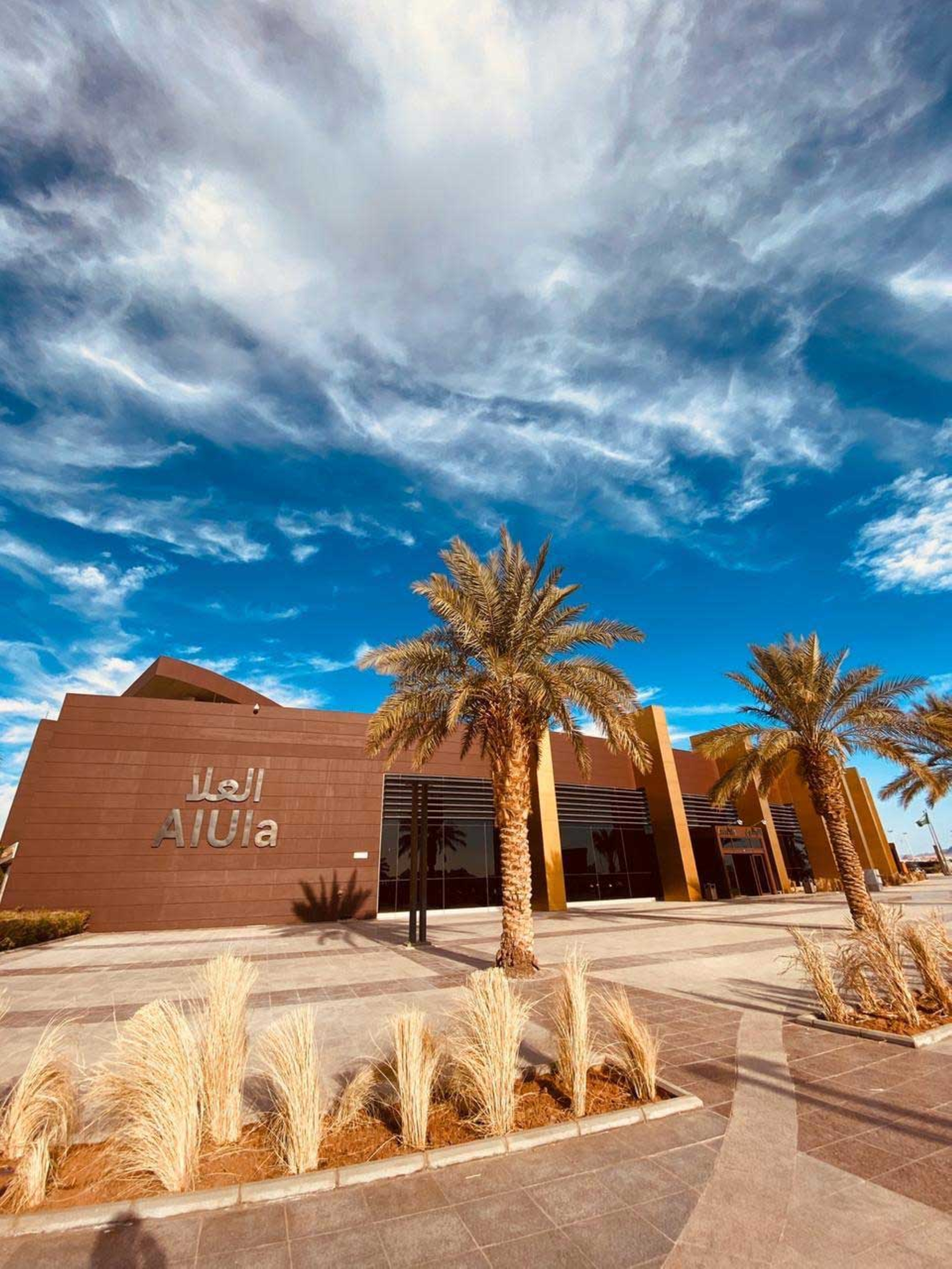
Inauguration
The airport was inaugurated in 2011, when an ‘Embraer’ aircraft, coming from King Khalid International Airport in Riyadh, landed, signaling the start of airport operations. Its capacity reaches 250,000 passengers (later increased to four hundred thousand passengers annually). The airport contains one terminal, with a total built-up area of 0.0037 km².
From domestic to international
It was initially established as a domestic airport, but in 2021, the General Authority of Civil Aviation (GACA) approved its conversion into an international airport, after meeting operational requirements according to international standards.
The airport launched its first international flight in 2022, with a direct flight between Cairo International Airport, operated by “Flynas' Airlines.
Prior to the airport's transition to an international airport, several development projects had been implemented at the airport since 2019, carried out by the General Authority of Civil Aviation in collaboration with the Royal Commission for al-Ula. These development works included doubling the capacity from one hundred thousand to four hundred thousand passengers annually, while the total area of the airport expanded to approximately 2.4 million m².
Facilities
The airport houses several facilities and services, including the executive lounge, as well as the security project headquarters, other services and facilities, and an investment-friendly environment. Furthermore, aviation apron capabilities increased to rank among the top ten airports in the Kingdom. The total area of the airport is 2.4 million m², while the aviation apron area spans 49,000 m², accommodating up to fifteen commercial aircraft simultaneously.
The General Authority of Civil Aviation anticipated the convening of the forty-first session of the Gulf Cooperation Council in al-Ula in 2021 by implementing aircraft taxiways at Prince Abdulmajeed Bin Abdulaziz Airport in al-Ula, covering an area of 181,000 m², to ensure the smooth flow of aircraft movement within the apron. Additionally, two taxiway connectors were added for entry and exit from the runway, making a total of three taxiways. Furthermore, aircraft parking positions were equipped with Visual Docking Guidance Systems (VDG) for marshaling.
Development
The Royal Commission for al-Ula Governorate announced in 2019 a project to develop the airport and increase its capacity to accommodate four hundred thousand passengers annually, in order to meet the growing demand from tourists to visit the province, especially with the comprehensive strategic plan for the development of al-Ula, which aims to attract two million visitors to al-Ula by 2035.
The project in its first phase includes expanding the airport to accommodate more aircraft, concurrently with the construction of a new VIP lounge, implementing a new digital information system in the arrival and departure halls, and enhancing the interior and exterior designs of the airport lounges.
The second phase of the airport expansion includes a new aircraft runway to facilitate access to al-Ula and enhance the experience of its visitors, both citizens and tourists. Additionally, this will contribute to enhancing the airport's capacity to receive direct international flights from regional and international destinations to al-Ula.
The airport designs were inspired by the natural environment, with the use of local materials in the construction process of passenger terminals. It features a mural using natural colors extracted from the environment of al-Ula, reflecting the city's nature and aligning with its heritage.
Abha International Airport
Abha International Airport (IATA: AHB, ICAO: OEAB), located in the city of Abha, the administrative capital of Aseer Province in the southwest of the Kingdom, was established in 1977. It is the only international airport in Aseer province, complemented by the domestic Bishah Airport. The airport is situated approximately thirty km away from the center of Abha City, the headquarters of the province's municipality.
Activity
The airport serves both domestic and international flights in the Kingdom, acting as an aerial gateway to Aseer Province, a tourist destination for visitors from within and outside the Kingdom. It ranks as one of the busiest airports in the south in terms of air traffic, with more than 35,027 international and domestic flights arriving and departing in 2019, carrying a total of 4,368,153 passengers.
From domestic to international
The lounges of Abha Airport were expanded in 2019, aiming to increase passenger capacity, as part of a series of projects to develop Saudi airports carried out by the General Authority of Civil Aviation. Following this, it was upgraded to an international airport in 2020, having previously been a regional airport. The operation of Abha International Airport is managed by the Airport Holding Company, a subsidiary of the General Authority of Civil Aviation. It can be directly accessed from within the city via King Fahd Road or King Faisal Road, approximately a thirty-minute drive away.
Redesign
In 2019, the General Authority of Civil Aviation signed a contract to redesign the new Abha International Airport. The contract includes designing a passenger terminal with a capacity of up to eight million passengers, designing an apron for the new terminal, and an area for supporting services and buildings, in addition to updating the overall project plan.
The new airport integrates the heritage and local culture of the region into its interior design. It also provides an investment-friendly environment inside the terminal and in the outdoor areas, considering the economic aspect of the design and the possibility of implementing projects through local companies and factories.
Development
Abha International Airport has witnessed development projects in its terminals, including the construction of a new international departure lounge covering an area of 805 m² with a capacity of 309 passengers. Additionally, a new international arrival lounge was built on an area of 1,030 m², capable of accommodating 340 passengers simultaneously. The expansion also included the addition of two escalators in the domestic departure lounge and another in the domestic arrival lounge, conveyor belts for passenger luggage, and twelve counters for travel procedures. Moreover, the main runway was rehabilitated, and a project was implemented to increase the number of aircraft parking spaces to thirteen. Furthermore, the current runway was rehabilitated to accommodate wide-bodied aircraft, and the parallel taxiway was expanded to forty-five m.
VIP lounge
The (executive) VIP lounge was inaugurated at the airport in 2022. The interior design of the project was aligned with the slogan of Aseer Province's strategy, 'Qimam and Shem,' aiming to position Aseer as a global tourist destination throughout the year, highlighting its distinctive nature, cultural landmarks, and tourist attractions that attract tourists from around the world.
The lounge amenities were designed to blend authenticity with modernity, equipped with facilities for people with disabilities, and environmentally friendly features such as natural trees and plants. The VIP lounge at the airport spans six hundred m², with a 100 percent increase in capacity, accommodating eighty-two passengers per hour. It is equipped with systems and services that meet the requirements and needs of travelers.
Prince Naif Bin Abdulaziz International Airport
Prince Naif Bin Abdulaziz International Airport (IATA: ELQ, ICAO: OEGS), is located west of Buraydah, the administrative capital of Qassim Province, in the heart of the Kingdom.
The airport was founded in 1971, and it is the only airport serving the region. It houses a single terminal, with a capacity to accommodate 550,000 passengers annually.
On July 5, 2012, an order was issued to change the name from 'Qassim Airport' to 'Prince Naif Bin Abdulaziz Airport'.
From domestic to international
The General Authority of Civil Aviation raised the classification of Prince Naif Bin Abdulaziz Airport in Qassim in 2017 to become an international airport, after it was previously classified as domestic and regional. The number of flights at the airport in 2010 did not exceed 4,885 flights, with 409,000 passengers. By 2016, the total number of flights at the airport had increased to 15,552 flights, with 1,718,560 passengers.
Thirteen airlines were operating at Prince Naif Bin Abdulaziz Airport in Qassim in 2017. Despite the official capacity of the airport being 450,000 passengers annually at that time, it received more than four times its capacity in 2016 through the hourly work system.
Growth rate
The number of flights at Prince Naif Bin Abdulaziz Airport in Qassim in 2010 exceeded 4,885 flights, carrying 409,000 passengers. In 2011, it recorded 5,948 flights and 595,171 passengers. In 2012, there were 7,347 flights with 771,878 passengers. In 2013, it handled 9,185 flights and 886,147 passengers. By 2014, there were 10,174 flights with 1,150,000 passengers. In 2015, it recorded 12,216 flights carrying 1,443,210 passengers, and by 2016, it exceeded 15,552 flights with over 1,718,856 passengers.
In 2019, the airport handled 7,920 international and domestic flights, carrying 1,832,737 passengers. The airport witnesses daily international flights to a number of destinations around the world.
Air traffic at Prince Naif Bin Abdulaziz International Airport in Qassim recorded more than 1.1 million passengers in 2022.
The first development of Prince Naif Bin Abdulaziz Airport
In 2015, the General Authority of Civil Aviation implemented a project to develop Prince Naif Bin Abdulaziz Airport in Qassim at a cost exceeding SAR1.048 million. The project aims to prepare the airport to accommodate three million passengers annually on domestic and international flights.
The project includes the construction of the main terminal building covering an area of sixty thousand m², a VIP lounge on an area of 3,500 m², and an airport mosque spanning 1,600 m². The airport administration building occupies an area of 2,800 m², accommodating airport departments along with meeting rooms. The airport facilities and services are designed to cope with future demand increases and implement future project plans.
The main terminals are divided into four floors, including departure and arrival floors, a service floor, and a baggage claim floor. The design emphasizes the principle of open layouts to ensure ease of operation and future expansion. The upper departure floor comprises the main operations hall, airline offices, ticketing services, line supervisors, depositor waiting areas, and investment spaces. It also includes security facilities, after which passengers move to an internal area with main passenger waiting lounges, such as boarding gates, first-class lounges, business lounges, open recreational areas, and investment spaces. A large water fountain spans the central area across nine bridges dedicated to passenger transportation to the aircraft.
The ground arrival floor houses passenger reception halls, passport office facilities, baggage collection services, and arrival waiting areas, in addition to investment spaces and service facilities. The mezzanine floor includes engineering services for the hall, including electrical and mechanical equipment, while the lower floor (lobby) of the hall is connected to multi-story parking lots to ensure ease of passenger movement to and from the parking areas.
The control tower building occupies a strategic location between the aviation side to ensure its functional performance and the building side to ensure its distinctive visibility. The project includes the construction of a new fire station equipped with a crisis management room and an upper control room, as well as the design of maintenance buildings, air navigation, airport staff housing, and housing for airport workers' families.
The second development of Prince Naif Bin Abdulaziz International Airport
The General Authority of Civil Aviation revealed, in 2023, a project for the development and operation study of Prince Naif Bin Abdulaziz International Airport in Qassim. It includes the construction of an additional terminal, covering an area of approximately 7,400 m², with a capacity to accommodate up to seven hundred thousand passengers annually. Additionally, there will be four departure gates and one arrival gate for domestic flights. The additional terminal will contribute to increasing the capacity by more than 150 percent from its current capacity and will also assist in organizing and designing passenger movement.
The additional terminal at the airport includes areas for departure procedures, featuring eleven counters, four self-service kiosks, baggage conveyors, three security inspection devices, four domestic departure gates, and one domestic arrival gate. The new terminal will be dedicated to domestic flights, while the old terminal will serve international flights.
Prince Sultan Bin Abdulaziz International Airport
Prince Sultan Bin Abdulaziz International Airport (IATA: TUU, ICAO: OETB) is located in Tabuk City, the administrative capital of Tabuk Province in the north of the Kingdom. Established in 2011, it has a capacity of one and a half million passengers annually. The airport has a single terminal, and the total built-up area of the airport is 0.0147 km².
The airport was built in the early 1970s as a dirt airstrip, until it was developed in 1978 and converted into a military base at that time.
It serves as the sole air gateway to Tabuk Province. Formerly known as Tabuk Regional Airport, it was upgraded to an international airport by the General Authority of Civil Aviation in 2011, becoming independent from the military base at a cost of approximately SAR242 million.
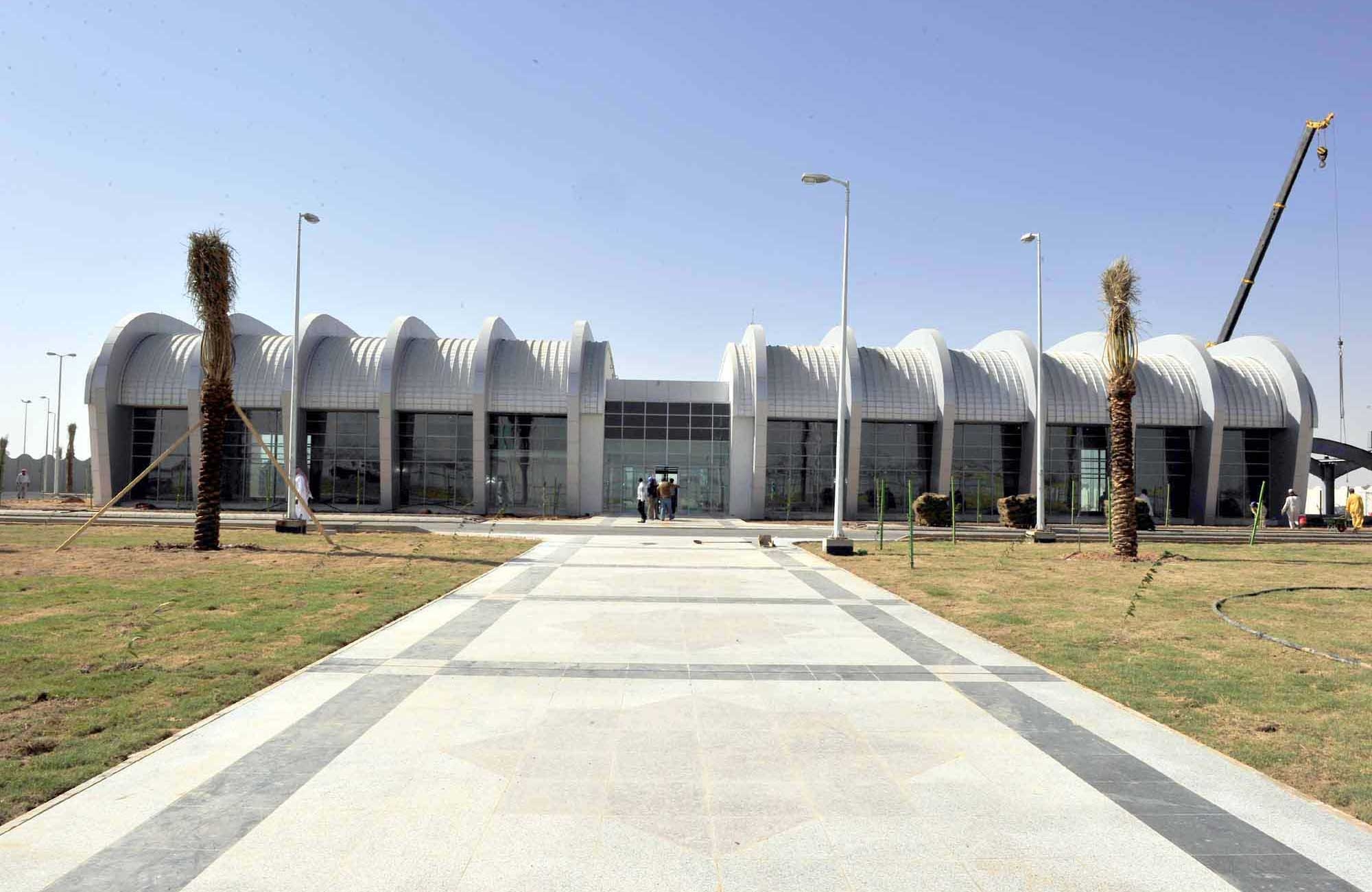
Significance
The airport's importance multiplied following the establishment of major economic projects in the western and northwestern provinces of the Kingdom: the 'NEOM' and Red Sea projects. Prince Sultan Airport has become the gateway for these projects to the world, serving both domestic and foreign airlines with regular flights to and from the airport. It is directly connected to thirty-six destinations, including twenty domestic ones.
Passenger traffic
Prince Sultan Airport is the seventh among the airports operated by the Cluster 2 Airports Company in terms of passenger density and number of flights. The total area of the airport is 16,400 m², with a capacity to accommodate one and a half million passengers annually, serving three international destinations: Dubai, Sharjah, and Cairo. Four airlines operate flights, namely: Flydubai, Air Arabia, Nile Air, and Nesma International Airlines. Additionally, there are three domestic destinations: Riyadh, Dammam, and Jeddah, served by three airlines: Saudia, “Flynas', and 'flyadeal'.
According to statistics from the General Authority of Civil Aviation, the number of passengers through the airport in 2019 reached 1,786,960 passengers, with a growth rate exceeding 12 percent compared to 2018, while the number of flights amounted to 16,014 flights, an increase of 11 percent from 2018.
The number of passengers on departing and arriving flights at the airport in 2020 reached 867,293 passengers on board 8,414 flights, while the number of flights in 2021 exceeded 12,273 flights carrying more than 1,329,412 passengers. In 2022, there were 13,914 flights carrying more than 1,562,865 passengers, with a growth rate of 18 percent in the number of passengers and 13 percent in the number of arriving and departing flights to and from the airport, compared to data from 2021 and 2022. The number of passengers in the first quarter of 2023 exceeded 437,000 passengers on board 3,433 flights.
Facilities
Prince Sultan Airport consists of passenger departure and arrival halls, a royal lounge, separate entrances and parking lots, an administration building, a mosque, a fire station, a backup power station, maintenance workshops, a cargo handling and receiving building, meteorological observation buildings, security buildings, a water treatment plant, internal road networks, along with landscaping and beautification.
The passenger halls are designed in the shape of an aircraft, with three covered moving bridges connecting them to the aircraft. They have entrances and exits on the sides for arrival and departure halls, allowing passengers to be transported by buses when necessary. The design takes into account providing services for people with special needs and the elderly, as well as modern technologies for passenger services, including flight announcements and automatic boarding pass retrieval. It also includes a separate lounge for VIPs, a first-class lounge, areas for food and beverage services, gifts and products, internet services and car rental, baggage wrapping area, banking and ATM services, as well as transportation, travel, and tourism services.
Al-Jawf International Airport
Al-Jawf International Airport (IATA: AJF, ICAO: OESK) is located in al-Jawf Province in the north of the Kingdom, about twenty-five km from the city of Sikaka, the administrative capital of the province. It was established as a domestic airport in 1974, coinciding with the establishment of Hail International Airport.
The airport serves as the primary air gateway for al-Jawf Province, catering to the governorates of al-Jawf Province and approximately sixty villages and their affiliated centers. It is supported by a domestic airport 357 km to the north in al-Qurayyat Governorate. Initially, its capacity was 175,000 passengers annually, housing a single terminal, with a built-up area of twenty-nine km².
Adoption of al-Jawf Airport as an international airport
Al-Jawf Airport was accredited as an international airport in 2018, transitioning from being a regional airport. This move aimed at fostering economic activity, enhancing operational efficiency at airports, facilitating travel, and increasing travel destinations for the residents of Saudi provinces.
In terms of air traffic density, it ranks as the third busiest airport in the northern region in terms of both flights and passengers. In 2019, the total number of international and domestic flights arriving at and departing from it reached 5,274 flights, carrying over half a million passengers.
Construction of the new al-Jawf International Airport
On November 21, 2018, the General Authority of Civil Aviation announced the laying of the foundation stone for the new al-Jawf Airport project, as part of the 'Unified Model for Airports B' project, which accommodates one million passengers annually.
The area for aviation-related activities in the 'Unified Model for Airports B' reaches 22,483 m², while the area for building-related activities is 47,000 m², and the passenger terminal area is 23,368 m². The number of travel procedure counters includes seventeen regular counters and eleven self-service counters, with six immigration counters for arrivals and four counters for departures, in addition to three bus gates, four passenger bridges, and baggage carousels. The approximate area for the external investment zone reaches one hundred thousand m².
The General Authority of Civil Aviation commenced construction works at al-Jawf International Airport in 2019. The airport facilities include a passenger terminal capable of accommodating seven hundred passengers per hour, two double bridges to directly connect the passenger terminal with the aircraft, in addition to three bus gates and parking lots. There is also an aircraft apron with a capacity for four aircraft simultaneously, prepared to handle two international and five domestic flights concurrently. The total area of the new al-Jawf International Airport is 411,950 m², comprising a passenger terminal, service buildings, parking lots, as well as service and investment facilities.
The new airport has the capacity to handle two international flights and five domestic flights simultaneously. It can accommodate six simultaneous Category C aircraft or two Category C aircraft simultaneously with two Category E aircraft. Additionally, the airport is equipped with modern operation and service systems.
Al-Ahsa International Airport
The international airport in al-Ahsa is referred to as 'HOF' by IATA and 'PEAH' by ICAO. Located in al-Hufuf, part of the al-Ahsa Governorate in the Eastern Province of the Kingdom, the airport is the second in the Eastern Province after King Fahd International Airport in Dammam. Established in 1985, the airport had a capacity of four hundred thousand passengers at that time, with a single terminal. The total built-up area of the airport is 477 km².
From domestic to international
Al-Ahsa Airport transitioned from domestic to international status in 2017. It achieved a growth rate of 30 percent in passenger numbers during 2022 compared to 2021, along with a 6.6 percent increase in the number of flights.
The General Authority of Civil Aviation has developed short and long-term plans to create an attractive environment for attracting commercial, cargo, and private airlines to al-Ahsa International Airport. Additionally, these plans aim to capitalize on investment opportunities to develop the aviation industry, enhance infrastructure, and increase capacity.
Significance
Al-Ahsa International Airport derives its importance from its location in the Eastern Province in general, and al-Ahsa Governorate in particular, which witness industrial and commercial activities, and various opportunities and projects. Additionally, the province's location overlooking five Gulf countries adds to its significance. On the commercial level, the Eastern Province accounts for 15 percent of the total commercial registrations in the Kingdom, with al-Ahsa Governorate comprising 17 percent of this share. The number of commercial registrations in al-Ahsa has grown by 30 percent.
Al-Ahsa is also distinguished by its tourist attractions, which have been able to attract tourists. The number of visitors exceeded two million in 2022, who spent more than SAR1 billion. The significance of tourism for the province increased after al-Ahsa Oasis was registered on the UNESCO World Heritage List in 2018. It boasts various tourist sites, including al-Qarah and al-Arba' Mountains, Dakhna, and al-Uqayr Beach.
Management
The management of al-Ahsa International Airport was transferred to Dammam Airports Company (DACO) on May 1, 2021, as part of the institutional transformation plan. The company implemented a development plan for investment activities at the airport, which included enhancing investment, developmental, and operational models. The institutional transformation goals for the airport encompass enhancing the operational capabilities of facilities, developing infrastructure, operating and maintaining facilities, investing in national expertise specialized in the aviation sector, and developing investment and commercial opportunities.
Expansion
In 2022, the General Authority of Civil Aviation implemented a project to expand and develop al-Ahsa International Airport, increasing its capacity by 250 percent to accommodate one million passengers annually. In its second phase, the project aims to raise the capacity to accommodate four million passengers annually.
The project includes the construction of two new international lounges with a total area of 3,400 m², the enhancement of its internal lounges, the increase of its operational capacity, the upgrading of its infrastructure, the increase of operational capacity for travel processing platforms, the development of baggage conveyor systems and technical infrastructure, the expansion and modernization of airport logistics equipment, and the introduction of various investment opportunities.
The development project of al-Ahsa International Airport also includes the expansion of departure and arrival lounges, the rehabilitation of existing lounges, the construction of long-term parking lots accommodating 437 spaces in addition to the previously existing seven hundred spaces, the rehabilitation of the parallel service line to the airport lounges extending 1.7 km, the construction of parking lots for ground equipment, and the architectural designs of the airport were inspired by the environment of al-Ahsa Governorate.
NEOM Bay International Airport
The Neom Bay Airport International was inaugurated on June 25, 2019, located in Sharma at the NEOM Bay in Tabuk Province, northwest of the Kingdom. Initially licensed by the General Authority of Civil Aviation as a commercial airport, NEOM Bay Airport became operational for commercial flights after the completion of the first phase of its development. It was accredited by the International Air Transport Association (IATA) with the code 'NUM'. In the first phase, NEOM Bay Airport operated regular flights to transport investors and workers involved in the NEOM project. This project comprised a team of over 1,500 local and international experts, representing more than sixty-five countries, along with business partners and investors from around the globe.
The airport's location stands out as approximately 40 percent of the world's population can reach it in under six hours, given its position at the crossroads of three continents.
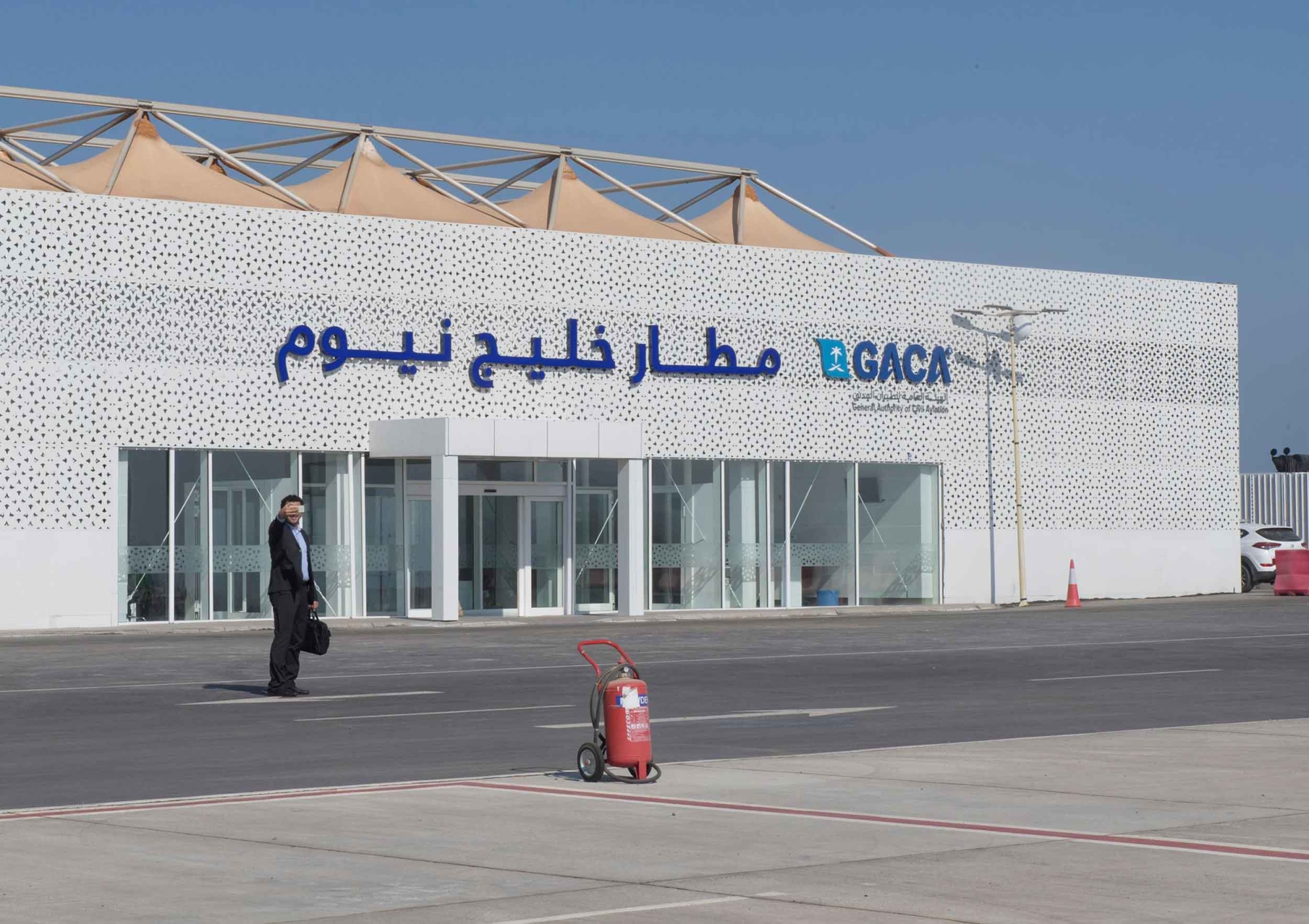
Flights initiation
In 2022, NEOM and Saudia launched regular international flights from NEOM Bay Airport to international destinations. It started with weekly flights to Dubai, then London. Saudia adorned its aircraft for flights to and from NEOM Bay Airport with shared designs that blend the identity of Saudia with the NEOM brand.
Hail International Airport
Hail International Airport is represented by 'HAS' in IATA and referenced as 'OEHL' in ICAO. Established in 1974, its capacity reaches five hundred thousand passengers annually, featuring one terminal. The total built-up area spans fifty-two km², located approximately five km south of downtown Hail City.
From domestic to regional and then international
At the outset of its establishment, Hail Airport was a domestic airport until the General Authority of Civil Aviation decided in 2016 to transform it into a hub serving the northern provinces of the Kingdom, connecting them with major airports. This provides travelers with several options to reach both domestic and international destinations as part of the 'National Hub Airports' project, implemented by the authority to support routes with reduced air traffic.
Hail Airport witnessed a 14.4 percent increase in the number of passengers in 2015 compared to 2014, while the increase in the number of flights reached 15 percent.
After a year of hub operation, Hail Airport recorded a 38 percent growth in the number of passengers and a 113 percent increase in domestic flights. The number of passengers on domestic flights through the airport since the start of hub operations in October 2016 until October 2017 reached approximately 925,082 passengers, while the number of domestic flights reached 13,413 flights.
In 2017, the General Authority of Civil Aviation decided to convert Hail Airport into an international airport.
Expansion
In 2012, the airport witnessed an expansion project, which included the construction of two terminals: one for international arrivals and the other for international departures. Additionally, there was an expansion of the entrances and parking lots of the new airport, organizing the outdoor area, and connecting the airport with a bridge and dedicated entrances after the completion of road management in Hail to construct a road connecting the end of the current airport terminal to the Hail-al-Madinah-al-Munawwarah Expressway, along with the construction of a bridge in front of Hail Airport.
In 2016, the airport witnessed the enhancement of services in the travel lounges for both domestic and international flights, as well as improvements in security, passport control, and customs facilities.
Al-Qaisumah International Airport
Al-Qaisumah International Airport (previously Hafr al-Batin International Airport) is denoted by 'AQI' in IATA and 'OEPA' in ICAO. Founded in 1962, it is located in the city of al-Qaisumah, affiliated with Hafr al-Batin Governorate, the Eastern Province of the Kingdom. Initially established as a domestic airport, it transitioned into an international airport in 2023.
Expansion
The General Authority of Civil Aviation awarded a national company the task of developing and expanding al-Qaisumah Airport in 2020, covering an area of 3,900 m². The expansion included the internal lounges and facilities provided to the airport within the expansion, as well as the service area and support buildings, the area for departure gates, passport platforms, and nine gates, including three for international departures and the same for domestic departures, and two gates for international arrivals, in addition to nine counters for completing travel procedures.
The project aims to increase the airport's capacity to accommodate seven hundred thousand passengers annually, expand the travel lounge area from 2,250 m² to 6,050 m², establish and develop the executive office covering an area of 304 m², construct an internal access lounge, increase the number of departure gates from six to twelve, expand parking capacity to accommodate six hundred cars instead of 181, increase the number of seats in the travel lounges from 137 to 491 seats, provide three modern security inspection devices, modern baggage conveyor belts, provide modern flight schedule display screens, Wi-Fi access points, develop a restaurant and cafeteria area, equip the airport with modern operating systems, and provide the necessary infrastructure facilities for the airport.
The expansion of al-Qaisumah Airport was inaugurated in 2022. In the same year, the new executive lounge was also inaugurated. The lounge area was increased by 150 percent, and the capacity was increased by 100 percent, with several facilities added, equipped with modern systems.
Institutional transformation
The management and operation of al-Qaisumah International Airport transitioned to the Dammam Airports Company in 2021. This company also operates King Fahd International Airport in Dammam and al-Ahsa International Airport. This move aimed to govern airport operations, develop them, open avenues for attracting local and international investments, expand partnerships with the private sector, enable business growth, support integration in the transportation and logistics services system, and enhance service quality for customers and travelers.
From domestic to international
The first international flights from al-Qaisumah International Airport took off on March 21, 2023, heading to Dubai City. The number of passengers from the airport has been increasing, with more than 223,000 passengers recorded in 2022, representing an increase of about 20 percent compared to 2021. Additionally, the number of flights exceeded 2,500 in 2022, marking an increase of about 8 percent compared to 2021.
Red Sea International Airport
The Red Sea International Airport (RSI) is located ninety km south of al-Wajh Governorate, situated in the western part of the Kingdom. Serving as a transit hub for travelers both by land and air, the airport facilitates flights to the destination within three hours for around 250 million people worldwide. The Red Sea International Airport received its first domestic flights in September 2023, while the first international flight arrived in April 2024.
Design
The Red Sea International Airport features an isolated parking area designated for emergency vehicles, along with an aircraft waiting area consisting of twelve seaplane ramps, twelve business aircraft ramps, and three helipads.
The Red Sea International Airport is the first carbon-neutral airport in the Middle East region, employing innovative sustainability solutions across all operations to eliminate carbon emissions, improve energy consumption, and enhance resource and waste management efficiency. This includes the use of local materials during design stages and integrating other elements, such as 100 percent renewable energy, to meet the minimum requirements of LEED Gold certification and reduce light pollution to comply with 'Dark Sky' guidelines. Another advantage of the innovative design of the Red Sea International Airport is its lounges, which are divided into five small passenger lounges that can be operated independently or simultaneously according to capacity requirements, reducing continuous energy usage compared to the approach of operating all lounges at all times.
Flights
The Red Sea International Airport welcomed its first international flight from Dubai International Airport on April 18, 2024, marking the inauguration of the new international route with two weekly flights to the Red Sea International Airport, in addition to domestic flights from Riyadh and Jeddah, operated by Saudia at the airport since September 2023.
King Abdullah Bin Abdulaziz International Airport in Jazan
In 1978, the airport was established as one of the regional airports of the Kingdom before it became an international airport. In 2019, the airport recorded 1,110 international flights carrying 146,000 passengers.
Prince Abdulmohsin Bin Abdulaziz International Airport in Yanbu
In 2010, the airport was established. In 2019, the airport recorded 2,071 international flights carrying 253,000 passengers.
Najran International Airport
In 2011, the airport was established, located about 7 km south of Najran City in southern area of the Kingdom, serving villages and provinces of the Najran Region. The number of passengers through Najran International Airport reaches approximately 1.4 million annually
Related quizzes
